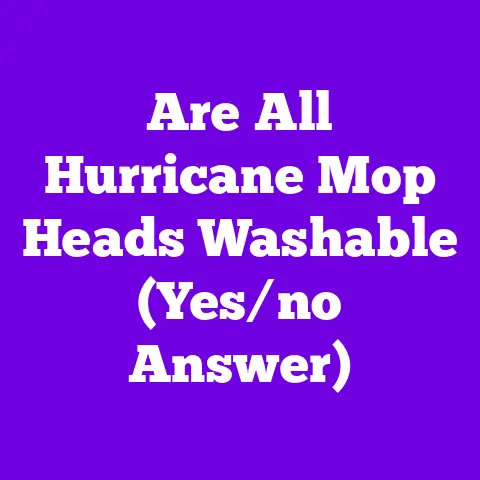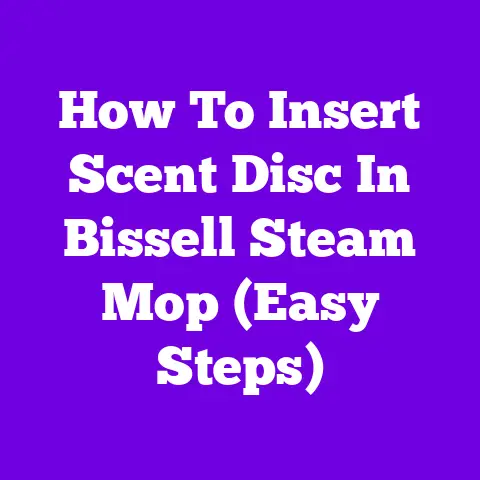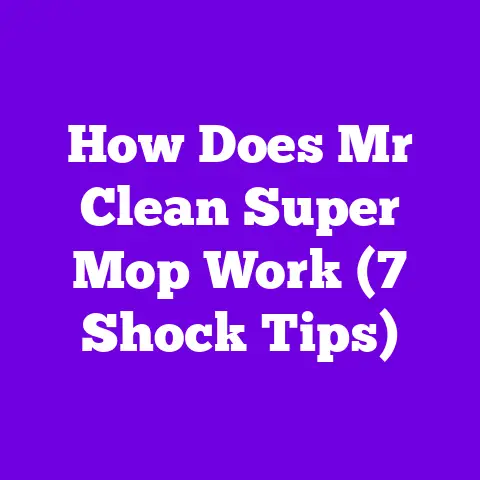Dispose of Old Mops & Cleaners (15 Eco-Friendly Disposals)
Mops are among the most popular cleaning items in the home, but they can wear off or become damaged if not handled with care.
It becomes very disgusting to have a heap of old or damaged mops in your house and it can occupy lots of space.
You should not rush to throw away your old Mops because there are many creative ways to recycle or re-use your old or damaged mops.
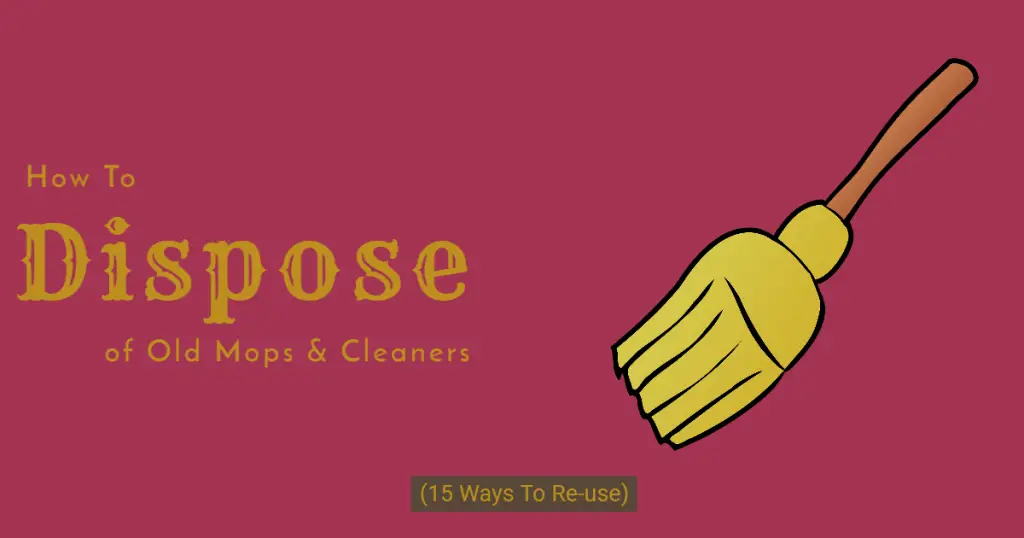
Key Takeaways
- Repurposing old mops can include cutting them into smaller pieces for dusting rags, using them as applicators for wood polish, soaking them in white vinegar for longevity, and attaching bottle caps or cans for narrow space cleaning.
- Recycling containers of cleaning products reduces environmental impact, conserves resources, and reduces pollution. It is important to check local recycling guidelines for proper instructions on recycling.
- Checking local recycling guidelines is essential for understanding proper disposal methods for old mops. Municipalities provide specific instructions for recycling, which can include reusing, disposing in designated bins, or repurposing. Soaking old mops in vinegar can enhance their longevity.
- Donating or giving away usable cleaning supplies can contribute to community organizations and prevent waste. Old mops can be repurposed for homeless shelters or community centers, and recycling centers accept old mop handles for new products. It is important to ensure cleanliness and check the organization’s requirements.
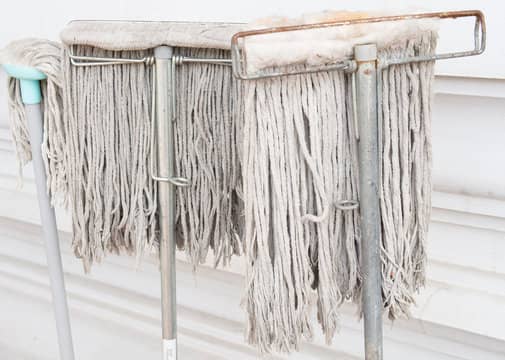
15 Ways of Dispose or Reusing Old Mops
- Cut them into smaller pieces and use them as rags for cleaning purposes.
- Use the mop head as a dust mop by attaching it to a broom handle.
- Repurpose the mop handle as a garden stake or support for plants.
- Donate the mop to a local animal shelter for use in cleaning and caring for animals.
- Use the mop head as a makeshift scrub brush for tough stains or grime.
- Cut off the mop head and use the handle as a paint stirrer or mixing tool.
- Use the mop head as a mop for cleaning outdoor areas like patio or garage floors.
- Cut the mop head into strips and use them as ties for plants in the garden.
- Repurpose the mop handle as a handle for a homemade cleaning tool, like a scrub brush or window squeegee.
- Use the mop head as a duster for hard-to-reach areas, like ceiling fans or high shelves.
- Cut off the mop head and use the handle as a handle for a homemade broom or brush.
- Use the mop head as a mop for cleaning windows or other glass surfaces.
- Cut the mop head into small pieces and use them as stuffing for pillows or cushions.
- Donate the mop to a local school or community center for use in art projects or crafts.
- Use the mop head as a cover for outdoor plants during cold weather to protect them from frost.
Using Up Cleaning Products
The suggested method for using up unused cleaning products involves finding alternative uses for them instead of disposing of them. This helps to reduce waste and minimize the need for disposal.
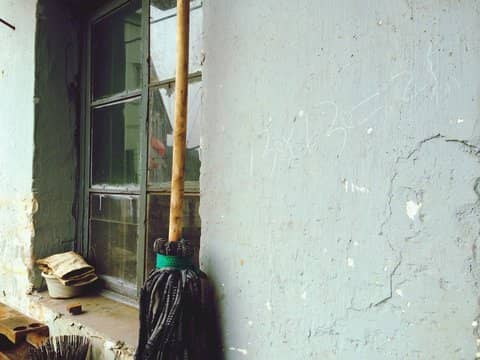
By exploring creative ways to repurpose or reuse old mops, we can contribute to a more sustainable approach in managing cleaning product waste.
Suggested method for using up unused cleaning products
One effective approach for utilizing surplus cleaning products involves finding alternative uses or repurposing them to reduce waste. There are several ways to achieve this goal:
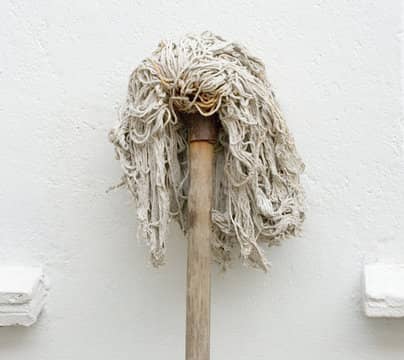
- Use leftover cleaning solution as a spot treatment for stains on carpets or upholstery.
- Dilute the cleaning solution with water and use it in a spray bottle as an all-purpose cleaner.
- Donate unused cleaning products to local recycling programs or hazardous waste collection programs.
By repurposing surplus cleaning products, we can minimize their environmental impact and extend their usefulness.
It is important to note that certain types of cleaning products, such as glass cleaners, may have specific disposal requirements due to their potentially hazardous nature. Before disposing of any cleaning product, it is advisable to consult with your local recycling coordinator or check if there are designated recycling centers available for plastic bottles and paper towels.
Reducing waste and minimizing disposal needs
To minimize waste and decrease the necessity for disposal, it is crucial to adopt strategies that prioritize reduction and prevention. One effective way to achieve this is by properly managing household hazardous waste.
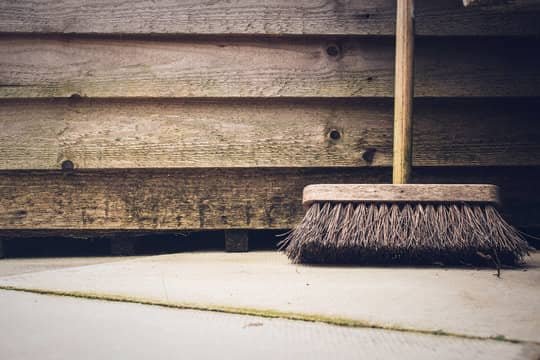
This includes products such as old mops, which can contain harmful chemicals that should not be disposed of in regular trash bins. Instead, individuals should take advantage of hazardous waste programs offered by waste disposal companies or local government agencies. These programs often provide convenient drop-off locations or curbside collection services for items like old mops. Another option is to explore recycling services specifically designed for hazardous materials. Recycling facilities can safely extract valuable resources from these products while ensuring they are not released into the environment through improper disposal methods. By implementing these measures, we can significantly reduce the amount of hazardous waste in our waste stream and protect both human health and the environment.
| Benefits | Methods |
|---|---|
| Reduces environmental pollution | Utilize hazardous waste programs provided by waste disposal companies |
| Prevents harm to human health | Participate in local hazardous waste collection events |
| Recovers valuable resources | Explore recycling services specifically designed for hazardous materials |
| Promotes sustainable practices | Properly dispose of old mops at designated drop-off locations |
Checking the Label for Disposal Instructions
The importance of reading product labels for hazardous substances cannot be overstated. It is crucial to understand the proper disposal methods for certain cleaners in order to prevent environmental contamination and potential health risks.
For example, some cleaners may need to be taken to a designated collection site or poured down the drain with plenty of water.
Importance of reading product labels for hazardous substances
Lack of awareness about the presence of hazardous substances in cleaning products is a potential threat to public health and safety. Many conventional cleaning products contain harmful chemicals that can be detrimental if improperly disposed of. To emphasize the importance of proper disposal, a table comparing hazardous and natural cleaning products can be included:
| Hazardous Cleaning Products | Natural Cleaning Products |
|---|---|
| Conventional cleaners containing toxic chemicals | Eco-friendly alternatives made from plant-based ingredients |
| Harsh solvents and corrosive ingredients | Gentle yet effective natural cleansers |
| Harmful fumes and strong odors | Pleasant-smelling, non-toxic options |
By reading product labels, individuals can identify any specific instructions for disposal. This helps prevent unsafe disposal practices such as dumping water contaminated with cleaning chemicals down the drain or throwing old mops in regular trash bins. Instead, unused cleaning products should be taken to designated recycling containers or hazardous waste facilities to ensure proper handling and minimize environmental impact.
Specific examples of disposal guidelines for certain cleaners
Examples of disposal guidelines for certain cleaners include:
Hazardous chemicals should never be thrown in the trash or poured down the drain; instead, they should be taken to designated hazardous waste collection centers.
Solid cleaning products can typically be disposed of in regular trash bins as well. Watersoluble cleaning products can often be safely diluted with water and flushed down the toilet or poured down the drain.
Floor care products should also be diluted with water before being disposed of through septic tank systems or poured down drains.
Multisurface cleaners and surface cleaners can generally be disposed of in plastic containers that are recyclable.
It is important to always follow specific disposal instructions provided on product labels for safe and environmentally-friendly disposal practices.
Proper Disposal Methods
The proper disposal of cleaning products without specific instructions is an important aspect of waste management. It is crucial to understand the potential environmental impact of these products and dispose of them in a responsible manner.
Additionally, recycling the containers used for these cleaning products can contribute to reducing waste and promoting sustainability.
Disposing of cleaning products without specific instructions
The proper disposal of cleaning products without specific instructions is a concern for many households.
However, it is important to note that certain cleaners, such as furniture polish, may require special instructions for disposal due to their potentially hazardous nature.
Throwing solid household cleaners or wipes in the trash
When disposing of solid household cleaners or wipes, it is important to consider proper waste management practices. To ensure environmentally friendly disposal, follow these guidelines:
- Check the product label for recyclable materials and separate them accordingly.
- Dispose of non-recyclable items in a solid waste landfill.
Avoid flushing dirty water or chemical cleaners down the drain.
Consider alternative options such as using eco-friendly, conventional, commercial, or multipurpose cleaners with reusable mops.
Special instructions for certain cleaners (e.g., furniture polish)
Special instructions may be necessary for the proper disposal of certain cleaners, such as furniture polish. It is important to follow these guidelines to ensure the safe and environmentally-friendly disposal or reuse of these products. Additionally, consider reusing the bottle for other purposes or refilling it with a homemade wood polish solution. For wooden floors, old mop cloths can be repurposed by cutting them into smaller pieces and using them as dusting rags or for applying wood polish.
| Recycled Material | Reusable Bottles | Wooden Floors |
|---|---|---|
| ✓ Furniture Polish | ✓ Refill with Homemade Wood Polish Solution | ✓ Repurpose Old Mop Cloths |
Recycling the containers
Recycling the containers of cleaning products is an important step towards reducing environmental impact.
Recycling helps in conserving resources and reducing pollution associated with the production of new materials.
However, it is essential to check local recycling guidelines as different areas may have specific instructions on what can be recycled and how it should be prepared for recycling.
Recycling benefits for the environment
One compelling reason to recycle is the positive impact it has on the environment.
Recycling helps in reducing water soluble and infectious waste, as well as minimizing the production of new plastic spray bottles and heavy-duty garbage bags.
It also encourages the use of natural cleaners, reusing shredded paper, and recycling glass bottles.
By recycling, we can prevent harmful materials like lead-based paint from ending up in landfills or polluting water sources.
Additionally, it promotes the use of soft cloth instead of disposable wipes, reducing accidental damage to surfaces.
Checking local recycling guidelines
Transitioning from the benefits of recycling to checking local recycling guidelines, it is crucial to understand proper disposal methods for old mops. Municipalities often provide specific instructions for trash removal and recycling, ensuring safe disposal.
When dealing with old mops, some options include:
- Reusing them for other cleaning purposes
- Disposing of them in designated bins or facilities
- Repurposing them as absorbent mats
Additionally, exploring alternative uses like soaking them in white vinegar in a utility sink can enhance their longevity.
It is important to check local recycling guidelines to determine the most appropriate method for disposing of old mops in your area. By following these guidelines, you can ensure that your old mops are disposed of properly and contribute to a more sustainable waste management system.
Donating or giving away usable cleaning supplies
This discussion focuses on the subtopic of donating or giving away usable cleaning supplies.
One key point is that contributing to community organizations can help ensure that still-usable cleaning supplies are put to good use by those in need.
By donating these items, individuals can maximize their use and prevent them from going to waste.
It is important to approach this topic objectively and impersonally, without the use of personal pronouns.
Contributing to community organizations
Contributing to community organizations can be a meaningful way of repurposing old mops and ensuring their continued usefulness in addressing local needs. By donating old mops, individuals can indirectly help those in need by supporting community organizations that cater to vulnerable populations.
The following sub-lists illustrate how these donated mops can benefit the community:
- Old mops can be used by homeless shelters to maintain cleanliness and hygiene.
- Community centers can repurpose old mop heads as paintbrushes for art classes or craft projects.
- Recycling centers may accept old mop handles to create new products like brooms or garden tools.
By considering these options, individuals contribute to their community’s well-being while reducing waste.
It is important, however, to make sure the donated mops are clean and free from any harmful substances. Additionally, it is advisable to check with each organization beforehand regarding specific donation requirements and guidelines.
Maximizing the use of still-effective products
To maximize the use of still-effective cleaning tools, it is noteworthy that an estimated 85% of mops are discarded prematurely due to lack of proper maintenance and care. Reusing old mops can be a sustainable solution to reduce waste and save money.
There are several ways to repurpose these still-effective products. One option is to cut off the mop head and use it as a scrub brush for various household cleaning tasks. The handle can be utilized as a garden stake or support for plants.
Additionally, the mop head can be soaked in soapy water or warm water mixed with vinegar to clean hard-to-reach areas like ceiling fans or blinds. The absorbent material of the mop head also makes it useful for soaking up spills or drying surfaces.
Furthermore, attaching bottle caps or aluminum cans to the end of the handle creates a makeshift broom that can reach narrow spaces easily. Alternatively, some people have repurposed old mops into robot vacuum covers by attaching them securely over the vacuum cleaner’s brushes, preventing tangling with pet hair or large debris.
Another creative use involves filling an old mop head with cat litter and using it as a homemade pet toy for cats to scratch on or play with. By exploring these ideas, individuals can prolong the life of their still-effective mops while reducing waste and finding alternative uses for everyday items in their homes.
Safety and Responsibility
Prioritizing safety when handling cleaning products is crucial to prevent accidents and health hazards.
It is important to carefully read and follow the instructions provided by the manufacturer to ensure proper usage and storage of these products.
Additionally, it is essential to adhere to local waste disposal regulations when disposing of unused or expired cleaning products to protect the environment and human health.
Prioritizing safety when handling cleaning products
Ensuring the safe handling of cleaning products is crucial in order to prevent accidents or harm from occurring.
Additionally, proper precautions should be taken when cleaning blood or other bodily fluids by wearing protective gloves and using disinfectants.
Steam cleaners should be handled carefully to prevent burns, and bleach water should never be mixed with ammonia or any other cleaning product as it can produce harmful gases.
Cold water should be used when diluting concentrated chemicals to prevent reactions and splashes.
When disposing of clinical waste, it is essential to follow proper protocols to prevent contamination.
Lastly, wax floors should be regularly maintained and paint chips avoided due to potential lead exposure which can cause serious health issues such as eye irritation.
In conclusion, prioritizing safety when handling cleaning products is vital in order to protect oneself from accidents and potential health risks.
Adhering to local waste disposal regulations
Adhering to local waste disposal regulations is an essential aspect of maintaining a clean and sustainable environment. These regulations are put in place to ensure that hazardous materials, including old mops, are disposed of properly and do not pose a threat to human health or the environment. Chemicals and bacteria from cleaning products can contaminate septic systems, leading to costly repairs and potential harm to the surrounding ecosystem. Additionally, improper disposal of cleaning products can contribute to pollution and negatively impact air quality. By following local waste disposal regulations, individuals can help reduce their carbon footprint and protect their communities from harmful substances.
| Disposal Method | Impact |
|---|---|
| Proper recycling | Reduces landfill waste |
| Donating for reuse | Extends product lifespan |
| Chemical-free cleaning | Minimizes environmental harm |
It is worth mentioning that reusing old mops before disposing them can also be beneficial for the environment. For example, they can be repurposed as rags for general cleaning tasks or used in DIY projects. Furthermore, instead of using chemical-based cleaners, opting for natural alternatives like vinegar can also help reduce the overall use of harmful substances while effectively disinfecting surfaces. Ultimately, adhering to local waste disposal regulations ensures that old mops are handled responsibly, minimizing negative impacts such as kidney damage from chemicals leaching into water sources or contributing unnecessarily to landfill waste.
Final Words
A Mop is specially knitted with strands of solid materials and it is well packaged and designed for efficient cleaning of the floor.
The stick of the Mop is connected to a hairy or corn husk material.
If the space in your house is occupied by old mops, then you can harness the old mops for another purpose.
The mop can be recycled and reused in many ways as explained above, but you should always maintain good hygiene by washing the mop cloth always.


